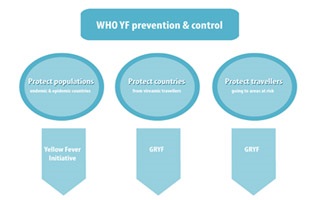Vaccine should be offered to all unvaccinated travellers aged ≥ 9 months, travelling to and from at-risk areas, unless they belong to the group of individuals for whom YF vaccination is contraindicated. In addition for travellers going to areas with low risk of YF transmission, although the vaccination is generally not recommended , it might be considered for the ones travelling for a long period to areas where they may be exposed to heavy load of mosquito bites.
Countries where the vectors and non-human primate hosts exist are vulnerable to the introduction or re-introduction of YF virus, even if the disease is not endemic. Importation of the virus by an infected traveller could initiate an enzootic transmission cycle, leading to a long-term infection risk for the local population. To prevent importation of YF virus, States may decide to require a proof of YF vaccination as a condition of entry to travellers coming from areas with risk of YF transmission.
The GRYF is a formal scientific and technical advisory group (3) on geographical yellow fever risk mapping, with the participation of countries with areas with risk of yellow fever, to:
- maintain up-to-date yellow fever risk mapping; and
- provide guidance on yellow fever vaccination for travellers in ways that facilitate international travel (4).
In order to achieve the above mentioned objectives, the GRYF will advise the IHR Secretariat on:
- The definition of criteria for inclusion/exclusion of countries/areas with risk of yellow fever transmission;
- The review of requests received from Members States including public health justification and scientific data to add or remove countries/areas with risk of yellow fever;
- Collection, reviewing and analysing new epidemiological data on yellow fever transmission;
- Proposals for revision of the list of countries /areas with risk of yellow fever transmission;
- Proposal for revision of the Yellow Fever risk mapping;
- Promoting the international harmonization of the Yellow Fever risk mapping;
- Establishment and maintenance of a centralized updated yellow fever country database with the aim of tracking history of risk mapping status changes per country (decision making, rationale, data).


